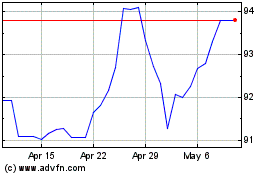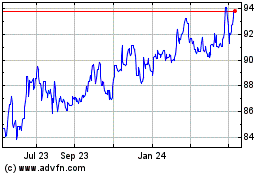The Antipodean currencies such as the Australia and the New
Zealand dollars weakened against their major currencies in the
Asian session on Wednesday, as Asian stock markets traded lower,
following the sell-off on the Wall Street overnight, as markets in
Australia, Japan, South Korea, Hong Kong, Singapore and Taiwan all
tumbled. Weak commodity prices, concerns about global economic
growth and uncertainty about the pace of U.S. interest rate cuts
weighed on the markets.
Traders reacted to data that showed a continued decline in U.S.
manufacturing activity in August, which led to renewed concerns
about the economic outlook.
The U.S. Fed is expected to lower rates at its next meeting
later this month, but there is some disagreement about the pace of
rate cuts. According to CME Group's FedWatch Tool, there is a 63.0
percent chance of a quarter-point rate cut later this month and a
37.0 percent chance of a half-point rate cut.
Weakness across most sectors led by mining and energy stocks
amid tumbling commodity prices, also weighed on the investor
sentiment.
Traders also reacted to data showing Australia's economy grew
less than expected in the three months to June and manufacturing
activity also remained contractionary in August.
Crude oil prices fell sharply to a nine-month low on prospects
of oversupply from OPEC weighed on oil prices. West Texas
Intermediate Crude oil futures for October ended down by $3.21 or
4.4 percent at $70.34 a barrel.
In economic news, Australia's gross domestic product expanded a
seasonally adjusted 0.2 percent on quarter in the second quarter of
2024, the Australian Bureau of Statistics said on Wednesday - in
line with expectations and accelerating from 0.1 percent in the
previous quarter. On a yearly basis, GDP added 1.0 percent - again
matching forecasts and slowing from 1.1 percent in the three months
prior.
Meanwhile, the services sector in Australia continued to expand
in August, and at a faster pace, the latest survey from Judo Bank
revealed on Wednesday with a services PMI score of 52.5. That's up
from 50.4 in July and it moves further above the boom-or-bust line
of 50 that separates expansion from contraction.
Data from Caixin showed that the services sector in China
continued to expand in August, albeit at a slower pace, with a
services PMI score of 51.6. That's down from 52.1 in July but
remains above the boom-or-bust line of 50 that separates expansion
from contraction.
In the Asian trading today, the Australian dollar fell to more
than a 2-week low of 97.02 against the yen and nearly a 2-week low
of 1.6523 against the euro, from yesterday's closing quotes of
97.58 and 1.6448, respectively. If the aussie extends its
downtrend, it is likely to find support around 94.00 against the
yen and 1.68 against the euro.
Against the U.S., the Canada and the New Zealand dollars, the
aussie slid to more than a 2-week low of 0.6685, nearly a 3-week
low of 0.9062 and a 2-day low of 1.0834 from Tuesday's closing
quotes of 0.6709, 0.9089 and 1.0842, respectively. The aussie may
tests support near 0.65 against the greenback, 0.88 against the
loonie and 1.06 against the kiwi.
The NZ dollar fell to nearly a 2-week low of 0.6169 against the
U.S. dollar and more than a 1-week low of 89.49 against the yen,
from Tuesday's closing quotes of 0.6183 and 89.94, respectively. If
the kiwi extends its downtrend, it is likely to find support around
0.59 against the greenback and 87.00 against the yen.
Against the euro, the kiwi dropped to a 1-week low of 1.7913
from yesterday's closing value of 1.7849. On the downside, 1.82 is
seen as the next support level for the kiwi.
Meanwhile, the safe-haven currency or the Japanese yen
strengthened against other major currencies in the Asian trading
amid risk aversion.
In economic news, the services sector in Japan continued to
expand in August, and at a steady pace, the latest survey from
Jibun Bank revealed on Wednesday with a services PMI score of 53.7.
That's unchanged from the July reading and remains above the
boom-or-bust line of 50 that separates expansion from
contraction.
The yen rose to nearly a 4-week high of 159.96 against the euro,
a 9-day high of 189.71 against the pound and an 8-day high of
170.66 against the Swiss franc, from early lows of 160.89, 190.86
and 171.44, respectively. If the yen extends its uptrend, it is
likely to find resistance around 158.00 against the euro, 186.00
against the pound and 168.00 against the franc.
Against the U.S. and the Canadian dollars, the yen climbed to a
5-day high of 144.75 and a 1-week high of 106.88 from early lows of
145.56 and 107.53, respectively. The yen may test resistance around
142.00 against the greenback and 104.00 against the loonie.
Looking ahead, PMI data from various European economies and U.K.
for August and Eurozone PPI for July are slated for release in the
European session.
In the New York session, U.S. MBA weekly mortgage approvals
data, U.S. and Canada trade data for July, U.S. Redbook report,
U.S. factory orders for July and U.S. Fed Beige book report are
slated for release.
At 9:45 am ET, the Bank of Canada will announce its interest
rate decision. The central bank is widely expected to lower its key
policy rate by 25 basis points to 4.25% from 4.5%.
Following the central bank's policy rate announcement, Bank of
Canada Governor Tiff Macklem will address the press conference at
10:30 am ET.
NZD vs Yen (FX:NZDJPY)
Forex Chart
From Oct 2024 to Nov 2024

NZD vs Yen (FX:NZDJPY)
Forex Chart
From Nov 2023 to Nov 2024
